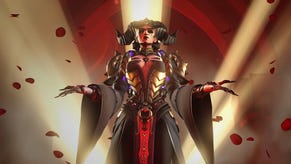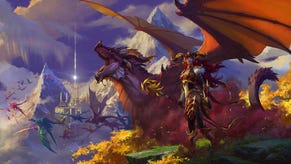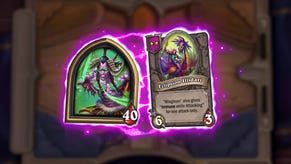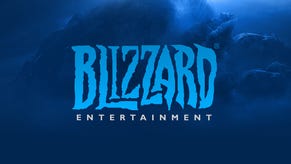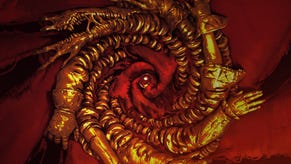Clash of the Cards: Hearthstone vs. SolForge
Hearthstone isn't the only digital collectible card game out there. But are its rivals any good? We put Blizzard's title up against SolForge, a title developed as a collaboration between Magic: The Gathering designer Richard Garfield and Ascension creators Stone Blade Entertainment.
This article first appeared on USgamer, a partner publication of VG247. Some content, such as this article, has been migrated to VG247 for posterity after USgamer's closure - but it has not been edited or further vetted by the VG247 team.
Blizzard's Hearthstone has established itself as the digital collectible card game of choice for many people, but it's not perfect.
It runs like crap on an iPad 2 (a device which it claims to support and which is still widely sold), it doesn't offer asynchronous play for those who don't have the time or the inclination to play a full game at once (a particularly important consideration for its mobile incarnation) and Blizzard's steadfast refusal to allow true global play means that if, say, European players want to compete against their American friends, they have to effectively start the game all over again.
So while, aside from these flaws, it's a fantastic game that you should really give a shot if you haven't already, there's plenty of scope for other titles to sneak in and cater to those players who don't feel Hearthstone is quite meeting their requirements.
One such example is SolForge, a Kickstarter-funded game that's been in development for some time now at Stone Blade Entertainment, the company behind the excellent non-CCG deckbuilding game Ascension in both its tabletop and iOS incarnations. SolForge is the result of a collaboration between Stone Blade and Magic: The Gathering designer Richard Garfield, and superficially might seem like a similar game to Hearthstone. So why bother checking it out?
Let's take a closer look and find out.

Basic Gameplay
Both games have a simple objective: reduce the opposing player's life to zero by playing creature and spell cards from your hand. In the meantime, you'll be trying to prevent your opponent from doing the same to you.
In Hearthstone, any creatures you play onto the board can attack from the turn after they're played. Unless your opponent has a creature with the "Taunt" ability, you can use your creatures to directly attack the opposing player at any time, though it's not always wise to.
In SolForge, meanwhile, you play creatures into "lanes" which are two cards tall -- one space for you, one for your opponent. Creatures in the same lane attack each other; creatures who have nothing opposite them in a lane will damage your opponent directly. It's a seemingly subtle change in the rules, but it has a big impact in how the game plays.
How a Match Develops
In Hearthstone, you begin with a paltry single mana point, and you add an extra mana point to your pool every turn. This means that, in most cases, you won't be playing your most powerful cards until late in the game because you won't have enough mana to do so. Thus, the early game becomes about putting yourself into a strong position so that when your opponent is able to get their beefiest cards out, you can deal with them no problem.
In SolForge, you can always play two cards from your hand every turn, and you draw a complete new hand every turn. Playing a card adds a more powerful version of the same card to your deck -- you can do this up to twice, since each card has three levels -- and every four turns, you level up. When this happens, you add all the improved cards to your deck, reshuffle it and begin drawing again. Thus, this slightly convoluted system means that, much like Hearthstone, you'll gradually increase in power as a match progresses -- but unlike Hearthstone, you have a certain amount of choice in terms of which cards you choose to develop to their full potential during a match itself.
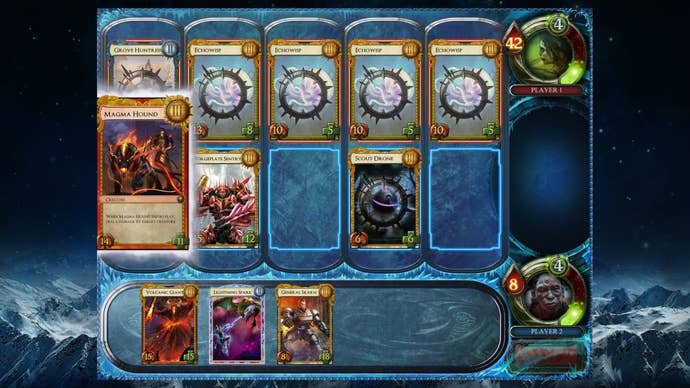
Progression
In Hearthstone, you unlock new classes by beating them, and unlock new cards for their basic deck by levelling up through playing games. "Expert" packs are awarded for completing certain objectives, or can be purchased from the in-game store using either gold or real money. You can also craft new cards by disenchanting old, unneeded ones and using the materials acquired.
In SolForge, there are no classes, but each deck you build may online include cards from up to two different factions at once. Thus, it's possible to build decks around specific themes, but it may take a little experimentation and exploration to discover what works for you, and it's not as immediately relatable as Hearthstone's classes, which are pulled right out of World of Warcraft.
SolForge has plenty of ways to acquire new cards. A daily login bonus more often than not rewards you with a free booster pack, and soft currency earned during play at a generous rate can be spent on booster packs also. Those willing to put in some real money can either purchase preconstructed decks themed around one of the factions, or pay for the guarantee that they'll get some rare or even "legendary" cards.
Neither game has a trading option.
Different Ways to Play
Hearthstone offers a practice mode against an AI opponent, the ability to play friendly games or ranked games, or the Arena mode, in which players draft cards from a selection rather than using their regular decks. Coming soon is the single player-centric Adventure mode, too, in which players will be able to take on well-known World of Warcraft bosses in exchange for appropriately themed cards.
SolForge features an array of different options -- play against a computer opponet, same-device pass-and-play multiplayer with an offline friend using just your decks; online play against friends or random opponents; plus a variety of tournaments for both constructed or drafted decks. Games can be timed or untimed, and can be played asynchronously at the two players' convenience. You can even set the game to play itself in a "bot battle" to get an idea of how your decks might stack up against one another in live combat.

Presentation
Hearthstone seemingly wins hands-down here with its dynamic animations, booming sound effects and satisfyingly tactile interface. It comes at a price, though; as previously mentioned, the game chugs like anything on an iPad 2, making it an unsatisfying, frustrating experience on a platform that would otherwise be ideal for it. (On later-model iPads, it performs just fine, but iPad 2s are both still reasonably widespread and on sale from Apple.)
SolForge, by comparison, adopts a much more simple approach to its presentation, with rudimentary animations and weedy, unsatisfying sound effects. When playing asynchronously, it's also sometimes difficult to see what your opponent has just done without consulting the (admirably comprehensive) text-based log; it would be preferable to see some clearer visual feedback when you switch to a game where it has just become your turn.
All that said, SolForge has some lovely card artwork -- good enough to make a tabletop player like myself pine for a physical version -- and atmospheric background music. It also performs flawlessly on older hardware (including the iPad 2), and even works fine on the tiddly screen of the iPhone; just expect to be doing a fair amount of double-tapping to reveal full card details until you familiarize yourself with the artwork.
Cross-Platform Play
Hearthstone runs on PC, Mac and iPad and requires a reasonably hefty download to play. SolForge runs on PC, iPhone and iPad and requires a reasonably hefty download to play. SolForge's advantage is that you can start a game on one device and finish it on another; in Hearthstone, single games are self-contained affairs.
Annoying Things
Hearthstone's servers are separated by geographical region, so if you discover after starting to play that all your friends are on a different region's server, you'll have to start all over again with a new collection of cards, everything locked and all your ranking progress reset. You can, of course, switch back and forth between the different servers as you see fit so this may not be too much of a problem for more casual players.
SolForge's asynchronous nature means that it can take a very long time to complete a single game, and in some cases you'll lose your opponent's interest before the match concludes. This can be mitigated to a certain extent by playing timed games, but it's an inherent problem with the asynchronous model. It also doesn't (yet) appear to support Steam notifications, so the only way to check if it's your turn on the PC version is to boot the game up and look.

Which One is Better?
It may sound like a cop-out to say so, but… they're both good, and they're both worth trying. And the beauty of them both being free-to-play -- non-exploitative, energy bar-free free-to-play, I might add -- is that you can try them both for yourself.
It's clear that both cater to different audiences. Hearthstone is the more instantly accessible game; its lovely visuals, animations and meaty sound effects make it something that even those who don't play a lot of tabletop games can pick up on without too much difficulty, while SolForge is seemingly designed for experienced collectible card game players.
Deckbuilding -- probably the most daunting aspect of this type of game -- is made friendly and easy to understand in Hearthstone thanks to the option of being guided through the process with suggested cards from your collection. In Solforge, meanwhile, you're largely left to just get on with it without guidance -- great for veterans of this kind of game, but not so good for players who aren't sure what a "good" deck looks like.
In short: give them both a shot and see which works for you. You can try Hearthstone for free here, and SolForge for free here.


